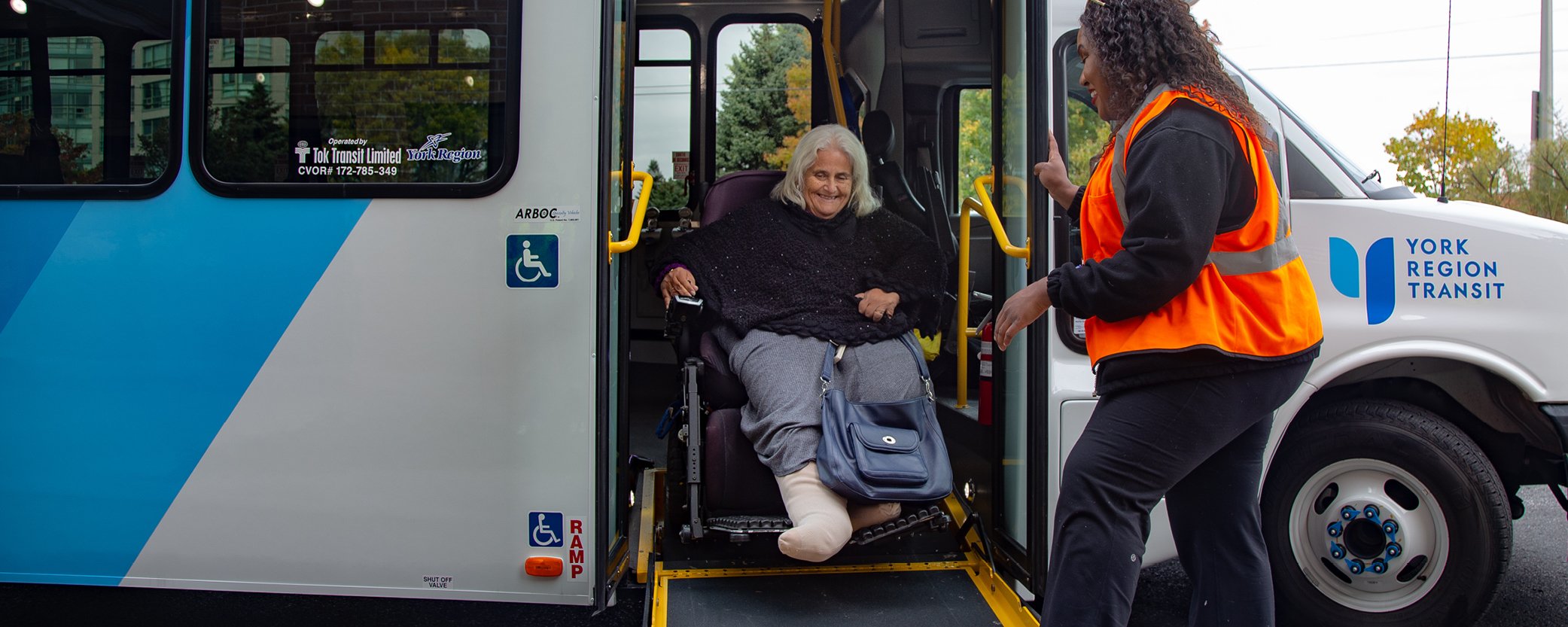
Accessibility and Accommodation
Accessible formats or communication supports are available upon request by contacting 1-866-744-1119.

All YRT services are accessible, meaning all buses are low-floor accessible and/or equipped with a ramp.
More than 65% of all YRT stops are accessible. Accessible bus stops are marked with an accessible symbol on the bus stop sign. Where a bus stop is not accessible, the bus operator will allow passengers who require an accessible stop to get on or off at the nearest location that is safe and acceptable to both the operator and customer.
|
Accessible vehicles |
||||||||
|
With over 500 vehicles in our fleet, YRT owns one of the largest bus fleets in Ontario. We strive to provide our customers with vehicles that are safe, clean and in reliable condition.YRT continues to improve its services by making it accessible for everyone in accordance with the Integrated Accessibility Standards of the Accessibility for Ontarians with Disabilities Act (AODA). Some of the accessible features on our fleet include:
|
||||||||
|
Automated announcements |
||||||||
|
All YRT vehicles are equipped with on-board audio equipment. The system will automatically announce next stop information 200 metres ahead of every stop. Coupled with the on-board VMS display, all customers (including those with visual or hearing impairments) will always be aware of upcoming stops during their ride. |
||||||||
|
Mandatory securement of mobility devices |
||||||||
|
The proper securement of personal mobility devices such as wheelchairs and scooters is mandatory on all YRT vehicles.For added safety, customers staying on their mobility devices during travel must use the lap belt as required by the Highway Traffic Act, section 106 (3). The bus operator will assist you with securing the device and using the lap belt.If you choose to use the rear-facing self-serve spaces on YRT buses, a lap belt must be used where provided. Securing of mobility devices is not required for rear-facing positions. |
||||||||
|
Priority and Courtesy Seating |
||||||||
|
Visit our Priority and Courtesy Seating page. |
||||||||
|
Travelling with bikes, electric scooters, strollers and other large objects |
||||||||
|
||||||||
|
Travelling with mobility aids |
||||||||
|
All mobility aids are to be stored within the reach of the passenger or in a secure place where it cannot cause harm to other passengers and will be returned to the passenger undamaged. Large mobility aids (walkers/rollators) are stowed separately only on Mobility On-Request Paratransit vehicles (Van/Sedan). Walkers, rollators, canes, crutches, prosthetics, oxygen tanks, etc. remain with the passenger.Persons using a Segway as a mobility aid must alight prior to boarding and the Segway must be secured to prevent injury when the bus is in motion. |
||||||||
|
Travelling with service animals and pets |
||||||||
|
You may bring support animals, including dogs on leashes and small non-exotic animals on-board YRT vehicles at the discretion of the vehicle operator unless:
Service animals are welcome to travel on YRT vehicles when accompanying customers with a disability. Service animals have training to perform specific tasks for people with disabilities, such as a guide, hearing or signal dog. Typically, most service animals may be identified by a harness or vest. If they are not easily identifiable, you may be asked to provide an identification card or letter from a healthcare practitioner, confirming that you require the animal for reasons relating to a disability. Small dogs are permitted on all On-Request services as long as dogs remain crated (i.e. in a carrier). Please note: No person may be accompanied on a transit vehicle or within a transit facility by any animal which an authorized officer has reasonable grounds to believe may be likely to cause harm, damage or discomfort to any person or property. |
||||||||
|
Travelling with a support person |
||||||||
|
YRT customers who need to be accompanied by a support person are required to carry a YRT Support Person Assistance Card. More details can be found on our Support Person Assistance Card page. |
||||||||
|
Travelling with visual impairments |
||||||||
|
With appropriate identification, members of the Canadian National Institute for the Blind (CNIB) or any other organization operating within York Region dealing with persons with visual impairments can travel free of charge on YRT services, including contracted TTC routes operating north of Steeles Avenue and Brampton Transit routes operating within York Region.Please note that all customers travelling on Mobility On-Request Paratransit services are required to pay fare. |
